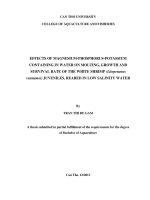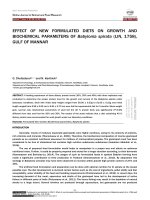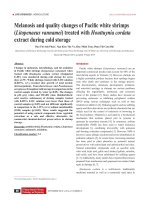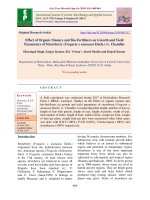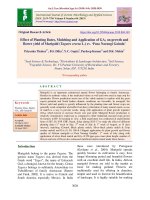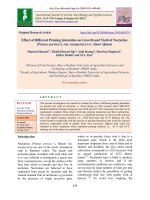Effect of de-oiled oil palm kernel meal based biofloc system on growth and digestive enzyme activity of pacific white shrimp, Litopenaeus Vannamei
Bạn đang xem bản rút gọn của tài liệu. Xem và tải ngay bản đầy đủ của tài liệu tại đây (295.06 KB, 11 trang )
Int.J.Curr.Microbiol.App.Sci (2017) 6(6): 1806-1816
International Journal of Current Microbiology and Applied Sciences
ISSN: 2319-7706 Volume 6 Number 6 (2017) pp. 1806-1816
Journal homepage:
Original Research Article
/>
Effect of De-Oiled Oil Palm Kernel Meal Based Biofloc
System on Growth and Digestive Enzyme Activity of Pacific
White Shrimp, Litopenaeus Vannamei
Karthireddy Syamala1*, W.S. Lakra2, N.K. Chadha3, N.P. Sahu4 and K. Pani Prasad5
1
ICAR-Central Institute of Fisheries Education, Kakinada centre, Kakinada,
Andhra Pradesh-533001, India
2
3
OSD Blue Revolution, Division of Aquaculture, ICAR-Central Institute of Fisheries Education,
PanchMarg, Yari Road, Andheri (w), Mumbai, Maharashtra-400 061, India
4
Fish Nutrition, Biochemistry and Physiology Division, 5Aquatic Environment and Health
Management Division, ICAR-Central Institute of Fisheries Education, PanchMarg, Yari Road,
Andheri (w), Mumbai, Maharashtra-400 061, India
*Corresponding author
ABSTRACT
Keywords
Oil palm kernel
meal, Biofloc,
Shrimp, FCR,
Protease, Amylase
Article Info
Accepted:
23 May 2017
Available Online:
10 June 2017
A 40-day experiment was conducted to study the effect of de-oiled oil palm kernel
meal based biofloc system on growth performance and digestive enzyme activity
of Litopenaeus vannamei. Juveniles of L. vannamei with an average weight of
(0.82±0.02 g) were stocked in tanks with a water volume of 150 L at a stocking
density of 300 PL m-3. Highest weight gain percentage (519.05±9.52), protein
efficiency ratio (1.78±0.02) and survival rate (88.67±0.88) were observed in oil
palm kernel meal based biofloc treatment. Lowest FCR value (1.61±0.02) has
been recorded in biofloc treatment. Although the digestive enzymes had not
shown any significant difference, a slight increase in the protease and amylase
activities have been observed in biofloc treatment. So the present study suggests
that non-conventional carbon source – de-oiled oil palm kernel meal can be
utilized for the development of biofloc.
Introduction
Limitation of aquaculture expansion area has
given rise to the concept of aquaculture
intensification. The major setback of the
aquaculture
intensification
is
the
accumulation of nitrogenous wastes and
environmental pollution which will result in
disease condition or death of the farmed
animals (Yang and Qiu, 2006; De Schryver
and Verstraete, 2009). The concept of
aquaculture intensification has raised many
environmental
and
social
concerns.
Aquaculture development needs the support
of aquaculture intensification coupled with
resource usage, environmental, social and
economic sustainability (Naylor, 2000;
Avnimelech, 2009). Biofloc technology has
the capability to meet all the prerequisites as
mentioned earlier.
1806
Int.J.Curr.Microbiol.App.Sci (2017) 6(6): 1806-1816
The Pacific white shrimp Litopenaeus
vannamei is the most widely cultivated
species in the world. Recently, L. vannamei
farming is facing some issues and problems in
the culture which needs a serious
contemplation. Diseases such as black gill
disease, White Spot Syndrome Virus
(WSSV),
Infectious
Hypodermal
Hematopoietic Necrosis Virus (IHHNV),
MonodonBaculo Virus (MBV), White muscle
disease, White gut disease, Muscle cramp
syndrome, Runt Deformity Syndrome (RDS),
Early Mortality Syndrome (EMS) and
Enterocytozoon
hepatopenaei
(EHP)
associated with severe growth retardation
have been reported in L. vannamei (Lightner
et al., 2012; Gunalan et al., 2014; Newman,
2015). In addition to the disease problems,
other issues like limited quarantine facilities,
production cost towards feed, quality seed
availability, feed quality and availability and
environmental impact and management are
also affecting the L. vannamei culture in India
(Babu et al., 2013).
Extensive studies on the biofloc based nursery
and grown out phases of L.vannamei in the
recent years had shown improvement in the
growth performance, feed utilization and
disease resistance (Burford et al., 2004; Hari
et al., 2004; Hari et al., 2006; Wasielesky et
al., 2006; Samocha et al., 2007; Ju et al.,
2008a; Kuhn et al., 2008; Xu et al., 2012,
2013). The carbon sources most widely used
for biofloc are molasses, cassava, wheat flour,
sorghum, corn flour, starch, glucose, cellulose
and dextrose (Emerenciano et al., 2013).
However, all these carbon sources already
have potential value and application in other
aspects which question their usage in the
biofloc production (Crab et al., 2012). Given
these, new research on biofloc production
using the low-cost non-conventional carbon
sources from agro-industrial residues is very
essential. Utilization of non-conventional
carbon sources for biofloc production can
convert these agro-industrial wastes into the
nutritious feed (Crab et al., 2012; Caipang et
al., 2015; Ahmad et al., 2017).
The present study evaluated the use of nonconventional carbon source, de-oiled oil palm
kernel meal (Elaeis guineensis), which is a
low-cost palm oil industry waste for biofloc
production. The effects of de-oiled oil palm
kernel meal on water quality, growth and
digestive enzyme activity of L. vannamei
were studied to assess the viability of this
carbon source in biofloc systems.
Materials and Methods
Experimental design and rearing
The present study was carried out at the
Brackish water Fish Farm of Central Institute
of Fisheries Education, Kakinada Centre,
Kakinada, East Godavari District, Andhra
Pradesh, India. An experiment of 40 days
with one control (clear water system) and one
treatment (oil palm kernel meal based biofloc)
with three replicates each following
completely randomized design (CRD) was
conducted. L. vannamei juveniles with an
average weight of (0.82 ± 0.02g) were
stocked in fibre reinforced plastics (FRP)
tanks with a water volume of 150 L at a
stocking density of 300 PL m-3.
The shrimps were fed at 5% of body weight
thrice a day (07.00 hrs 12.00 hrs and 17.00
hrs) with a commercial pellet feed (35 %
crude protein; 5 % lipid; 25 % carbohydrate).
The feed was adjusted according to the
changes in the biomass during the
experimental period. The control tanks were
fed with only commercial feed whereas the
biofloc treatment tanks were supplied with
both feed and carbon source. No water
exchange was carried out in biofloc treatment
tanks.
1807
Int.J.Curr.Microbiol.App.Sci (2017) 6(6): 1806-1816
Preparation of biofloc and carbon source
addition
The carbon source used in the present study,
Oil palm kernel meal was obtained from
Ruchi soya industries limited, palm oil
division at Peddapuram, East Godavari
District, Andhra Pradesh, India. Avnimelech
(1999) methodology with 20 g L-1 pond soil,
10 mg L-1 ammonium sulphate, and 400 mg
L-1 carbon source was used for the preparation
of biofloc inoculum. The suspension was well
aerated for 24 hrs and later mixed into
experimental tanks. Oil palm kernel meal was
added regularly to maintain a C: N ratio of
15:1 following De Schryver et al., (2008).
The pre-weighed oil palm kernel meal was
mixed with water and uniformly distributed in
the biofloc treatment tanks.
Water quality
Water quality parameters such as salinity,
temperature, dissolved oxygen, pH, total
alkalinity, total ammonia nitrogen (TAN),
nitrite and nitrate were observed and analyzed
as per standard procedures (APHA, 1998).
Water temperature, pH and dissolved oxygen
were determined daily. Alkalinity, TAN,
nitrite and nitrate were estimated weekly
twice. Biofloc volume was determined
weekly using Imhoff cones after 30 minutes
sedimentation (Avnimelech and Kochba,
2009).
furnace methods, respectively. Nitrogen
content was evaluated by the Micro-Kjeldahl
method (Pearson, 1976) and crude protein
level was calculated by multiplying the
percentage nitrogen with 6.25. Lipid was
determined by acid hydrolysis (Neilsen,
2010). Carbohydrate content was determined
by the difference between 100% and the sum
of values of moisture, protein, fibre, lipid and
ash. The percentages of the crude protein, ash,
crude lipid, fibre and carbohydrate were
calculated on dry weight basis of the carbon
source and biofloc.
Zootechnical performance
The growth performance of shrimps, length
and weight of the shrimps (n=30) were
recorded at a regular interval of 10 days. The
parameters evaluated included, Specific
Growth Rate (SGR, %/day-1) = [(ln Final
weight – ln Initial weight) / Number of days]
X 100; Feed Conversion Rate (FCR) = Feed
given (dry weight) / Body weight gain (wet
weight); Feed Efficiency Ratio (FER) = Body
weight gain (wet weight) / Feed given (dry
weight); Protein Efficiency Ratio (PER) =
Body weight gain (wet weight) / Crude
Protein in feed; Survival (%) = (Total number
of animal harvested / Total number stocked) x
100.
Digestive enzyme activity
Proximate analysis
At the experiment end, hepatopancreas of
shrimps (n=5) were collected from each
treatment tank for enzymatic analysis.
The crude protein, ash, crude lipid, fibre and
carbohydrate of the carbon source and biofloc
were analyzed using standard methods
(AOAC, 1995). Biofloc samples were
collected water through a 10 μm mesh nylon
bag (Xu et al., 2012) and were dried in an
oven at 105 °C until constant weight was
achieved. Protein, lipid and ash contents were
estimated by kjeldahl, soxhlet and muffle
A 20% tissue homogenate of hepatopancreas
was prepared with 0.25 M chilled sucrose
solution.
The
tissue
solution
was
homogenized and centrifuged at 8000 rpm for
10 minutes for removal of tissue debris. The
supernatant was collected and stored in -20°C
until further analysis.
1808
Int.J.Curr.Microbiol.App.Sci (2017) 6(6): 1806-1816
Amylase activity of samples was determined
using the DNS method by measuring the
absorbance at 540nm (Bernfeld, 1955). One
unit of amylase is defined as micromoles of
maltose produced per min at 37 ºC. The
Protease activity of samples was estimated by
casein digestion method, and the final
absorbance was measured at 280 nm (Liu et
al., 1991). The protease activity was
determined from the tyrosine standard curve,
and one unit of protease activity was defined
as micromoles of tyrosine released per min
per mg protein at 37 °C.
Statistical analysis
The statistical analysis of growth, digestive
and proximate parameters was analyzed by
one-way analysis of variance (ANOVA) using
SPPS (version - 22.0). Duncan’s multiple
range tests were used for post hoc comparison
of mean (p<0.05) between different groups.
All the data presented in the text, figures and
tables expressed are mean ± standard error
and statistical significance for the test was set
at p<0.05.
Results and Discussion
Water quality
Water quality parameters observed in the
present study are given in table 1. The water
temperature was recorded between 26-28°C
and had not shown any significant difference
(p>0.05) between the treatments. Salinity was
observed at 7ppt and showed no significant
difference (p>0.05). Dissolved oxygen had
not shown any significant difference (p>0.05)
between treatments and mean DO value was
between 5.50-5.57 mgL-1. pH value varied
significantly (p<0.05) among the treatments
and lowest pH was recorded in biofloc
treatment. Alkalinity values had shown
significant difference among treatments and
the mean ranged from 153.10-161.90 mg
CaCO3L-1. A significant difference (p>0.05)
was not observed in the TAN values among
the treatments, but the highest TAN value of
1.5 mgL-1 was recorded in biofloc treatment.
A significant difference (p<0.05) was
recorded in nitrite and nitrate values. The
highest nitrite and nitrate values of 2 mg L-1
and 40 mg L-1 were recorded in biofloc
treatment.
Proximate analysis
The proximate analysis of de-oiled oil palm
kernel meal and biofloc are given in table 2.
The de-oiled oil palm kernel meal contained
15.58% crude protein, 6.8% crude lipid,
3.53% ash, 30.29% carbohydrate and 35.83%
fibre. Biofloc comprised of 22.96% crude
protein, 3.8% crude lipid, 4.7% ash, 26%
carbohydrate and 14% fibre.
Zootechnical performance
The zootechnical performance of L. vannamei
recorded at the end of 40 days is given in
table 3.
The initial individual weight has not shown
any significant difference (p>0.05) among the
treatments. The final individual weight,
specific growth rate, weight gain, feed
conversion efficiency and survival rate of the
control was significantly lower than the
biofloc treatment. The PER and FCR had
shown a significant difference (p<0.05)
among the treatments and the highest value of
PER (1.78±0.02) and lowest FCR (1.61±0.02)
were recorded in biofloc treatment.
Digestive enzyme activity
Protease and amylase activities of the
treatments are given in figure 1. Although no
significant difference (p>0.05) was observed,
slightly higher protease and amylase activities
were found in biofloc treatment.
1809
Int.J.Curr.Microbiol.App.Sci (2017) 6(6): 1806-1816
Water quality
All the water quality parameters observed in
the present study were in the optimum range
for L. vannamei culture (Van Wyk and Scarpa
1999; Cohen et al., 2005; Mishra et al., 2008;
Fast and Lester, 2013). pH value has shown
significant difference among the treatments.
The reduction of pH value in the biofloc
treatments may be attributed to the respiration
of the microbes in the biofloc and
accumulation of carbon dioxide concentration
(Wasielesky et al., 2006). Significantly lower
alkalinity values were observed in biofloc
treatments, which may be due to the oxidation
of ammonia into nitrate and respiration of
microbes in the heterotrophic system (Ebeling
et al., 2006). No significant difference was
observed in the TAN values among the
treatments. Lesser TAN values in the present
study indicate the active nitrification process
and the presence of heterotrophic bacteria
(Vinatea et al., 2010). Significantly highest
nitrate value of 40 mg L-1 was recorded in
biofloc treatment. Reduction in TAN, nitrite,
alkalinity and accumulation of nitrate in the
study indicates the presence of nitrifiers
(Cohen et al., 2005; Ebeling et al., 2006). The
results of water quality indicate the efficiency
of the de-oiled oil palm kernel meal based
biofloc system.
Proximate analysis
Alcohols, sugars, starches and fibres are the
suggested sources of carbon for biofloc
production (Martinez-cordova et al., 2015).
Carbon source used in the present study has a
considerable amount of carbohydrate as well
as fibre which together contribute about 66%.
The added advantage of these complex carbon
sources (starch and fibre) is that it acts as a
substrate for the aggregation of bacteria and
helps in maintaining the organic carbon
release for longer periods(Martinez-cordova
et al., 2015). De-oiled oil palm kernel meal
has a crude protein level of 15.5% which can
act as an additional protein source for the
cultured animal (if ingested directly or
through biofloc). The nutritional composition
of biofloc was in range as already reported by
many researchers in fish as well as crustacean
based biofloc technology (Ekasari et al.,
2010; Megahed, 2010).
Fig.1 Specific activities of protease (unit’s min-1 mg-1 protein) and amylase (unit’s min-1 mg-1
protein) in the hepatopancreas of L. vannamei juveniles at the end of 40 days experiment
1810
Int.J.Curr.Microbiol.App.Sci (2017) 6(6): 1806-1816
Table.1 Water quality parameters (mean ± S.E and range) observed in the present study
Parameters
Treatments
Control
Biofloc
DO
(mgL-1)
pH
Alkalinity
(mg CaCO3 L-1)
TAN
(mgL-1)
NO2(mgL-1)
NO3(mgL-1)
Temperature
(°C)
5.57±0.10
(4.7, 6.5)
5.50±0.13
(4.5, 6.5)
7.99±0.04b
(7.4, 8.2)
7.70±0.10a
(6.7, 8.2)
161.90±2.14b
(140, 180)
153.10±1.40a
(140, 160)
0.27±0.04
(0, 0.5)
0.44±0.09
(0, 1.5)
0.19±0.03a
(0.1, 0.5)
0.85±0.11b
(0.3, 2)
1.37±0.08a
(1, 2)
25.00±1.65b
(10, 40)
26.57±0.13
(26,28)
26.52±0.13
(26,28)
Table.2 Proximate composition of De-oiled Oil palm kernel meal and Biofloc expressed as % dry matter
Crude protein
Crude lipid
Ash
Carbohydrate
Fibre
De-oiled Oil palm
kernel meal
15.58 ± 0.36
6.8 ± 0.19
3.53 ± 0.24
30.29 ± 0.35
35.83 ± 0.32
Biofloc
22.96 ± 0.30
3.8 ± 0.11
4.7 ± 0.19
26 ± 0.27
14 ± 0.41
Table.3 Growth performance and feed utilization of L. vannamei juveniles at the End of 40 days experiment
Initial individual weight (g)
Final individual weight (g)
Weight gain (%)
SGR (%/day)
FCR
FCE
PER
Survival (%)
Treatments
Control
Biofloc
0.83±0.02a
0.81±0.02 a
3.55±0.08 a
4.99±0.08 b
a
329.20±7.09
519.05±9.52 b
3.64±0.04a
4.56±0.04 b
b
1.86±0.01
1.61±0.02a
0.54±0.004a
0.62±0.006b
a
1.54±0.01
1.78±0.02 b
84.67±1.45 a
88.67±0.88 b
1811
Salinity
(ppt)
7
7
Int.J.Curr.Microbiol.App.Sci (2017) 6(6): 1806-1816
Zootechnical performance
In the present study, utilization of nonconventional carbon source de-oiled oil palm
kernel meal had shown a significant effect on
the growth performance and feed utilization
of L. vannamei. The increase in growth
performance and feed utilization of the
shrimps reared in biofloc were reported by
several researchers (Kuhn et al., 2010;
Megahed., 2010; Emerenciano et al., 2011;
Krummenauer et al., 2011; Ray et al., 2011;
Emerenciano et al., 2012; Xu and Pan, 2012;
Kim et al., 2014; Ray and Lotz, 2017). In
addition to this, biofloc acts as a supplemental
feed source which results in the better
zootechnical performance (Burford et al.,
2004; Kuhn et al., 2008; Megahed, 2010).
The nutritional requirement of L. vannamei is
30-36% crude protein, 6-8% lipid, 15-20%
carbohydrate (Zhu et al., 2010; Shahkar et al.,
2014; Wang et al., 2014; Li et al., 2015).
Biofloc is known to provide additional
protein, lipid, vitamin and mineral for shrimp
growth (Izquierdo et al., 2006; Wasielesky et
al., 2006; Ju et al., 2008b).
According to Lin et al., (2007), the exogenous
enzymes in the diets increase the efficiency of
the digestion process. The microbes
associated with biofloc are assumed to
produce exogenous enzymes which help in
the breakdown of proteins, carbohydrates and
other nutrients into smaller units which
improved the feed digestibility and absorption
(Xu and Pan, 2012). The microbes in the
biofloc once ingested by shrimp acts as an
extracellular enzyme source and improve the
digestive function. So as a supplemental feed
source and external enzyme source, biofloc
might have assisted in enhancing the growth
performance and feed utilization in the
present study. Studies reported low FCR
values in the biofloc treatments which may be
due to the additional contribution of the
biofloc to the shrimp nutrition (Wasielesky et
al., 2006). Present study recorded a survival
rate of 88.67±0.88 in the biofloc treatment
which is significantly higher than control as
reported in an earlier study (Mishra et al.,
2008).
Digestive enzyme activity
The main site of digestion and absorption in
shrimps are intestine and stomach with the
help of digestive enzymes secreted by
digestive gland (Dall et al., 1990). The
digestive enzyme activity in hepatopancreas
has not shown any significant difference.
However, slight increases in protease and
amylase activities were observed in biofloc
treatment. A similar result was reported by
Xu and Pan, 2012 in L. vannamei, where a
slight increase in the amylase and protease
activities of the biofloc treatments without
any significant difference was observed.
Biofloc is assumed to be cellular nutrition
source due to the presence of various
bioactive compounds and unknown factors
(Ju et al., 2008b). Shrimps grown in biofloc
are speculated to change digestive enzyme
activities in response to the changes in the
diet conditions (Le Moullac et al., 1996; Xu
and Pan, 2012). The biofloc is presumed to
enhance the production or activity of the
digestive enzymes which in turn contributed
to the better growth and feed utilization (Moss
et al., 2001; Xu et al., 2012, 2013).
The present study explored the potential of
non-conventional carbon source, de-oiled oil
palm kernel meal in the biofloc development.
As the research is progressing in the biofloc
systems in aquaculture, the need and search
for the cheaper carbon sources is increasing.
Utilization of carbon sources which already
have an application in others fields will not be
a befitting option for aquaculture biofloc
systems. Using the agro-industrial byproducts/wastes for the production of
aquaculture biofloc systems can help in the
1812
Int.J.Curr.Microbiol.App.Sci (2017) 6(6): 1806-1816
recycling of these materials into useful,
nutritious feed for the aquatic organisms. So
the present study suggests that oil palm
industry waste and non-conventional carbon
source (de-oiled oil palm kernel meal) can be
used as a potential alternative cheaper carbon
source for commercial biofloc production
systems.
Acknowledgements
The authors are thankful to The Director and
Vice-chancellor,
ICAR-CIFE
for
his
cooperation and encouragement throughout
this study.
References
Ahmad, I., A.M. Babitha Rani, A.K. Verma and
Maqsood, M. 2017. Biofloc technology:
an emerging avenue in aquatic animal
health care and nutrition. Aquaculture
International, 1-12.
AOAC 1995. Official Methods of Analysis,
Association of Official Analytical
Chemists, 15th edn, Washington DC.
APHA 1998. Standard methods of the
examination of water.15th edn. American
Public Health Association, Washington,
D.C: pp. 1193.
Avnimelech, Y. 1999. Carbon / nitrogen ratio as
a control element in aquaculture systems.
Aquaculture. 176: 227˗235.
Avnimelech, Y. 2009. Biofloc technology.A
practical guide book. The World
Aquaculture Society, Baton Rouge.
United States. 182pp.
Avnimelech, Y. and Kochba, M. 2009.
Evaluation of nitrogen uptake and
excretion by tilapia in biofloc tanks, using
15 N tracing. Aquaculture, 287(1): 163168.
Babu, Y.M., K.R. Ramudu, S.S. Dana and
Dash, G. 2013. An overview on
Litopenaeus vannamei farming practices
in India, current issues, problems and
future perspectives. International Journal
of Current Research, 5(08): 2118-2122.
Bernfeld, P. 1955. Amylase a and b. Methods in
Enzymology. 1: 149-151.
Burford, M.A., P.J. Thompson, R.P. McIntosh,
R.H. Bauman and Pearson, D.C.
2004.The contribution of flocculated
material
to
shrimp
(Litopenaeus
vannamei) nutrition in a high-intensity,
zero-exchange system. Aquaculture,
232(1): 525-537.
Caipang, C.M.A., H.X. Choo, Z. Bai, H. Huang
and Lay-yag, C.M. 2015. Viability of
sweet potato flour as carbon source for
the production of biofloc in freshwater
culture of tilapia, Oreochromis sp.
International Aquatic Research, 7(4):
329-336.
Cohen J., T.M. Samocha, J.M. Fox and
Lawrence,
A.L.2005.Biosecured
production of juvenile Pacific white
shrimp in an intensive raceway system
with limited water discharge. Aquaculture
Engineering32:425˗442.
Crab, R., A. Lambert, T. Defoirdt, P. Bossier
and Verstraete, W. 2012.The application
of bioflocs technology to protect brine
shrimp (Artemia franciscana) from
pathogenic Vibrio harveyi. Journal of
Applied Microbiology, 109: 1643˗1649.
Dall, W., B.J. Hill, P.C. Rothlisberg and
Staples, D.J. 1990. The Biology of the
Penaeidae Advances in Marine Biology,
27: 25˗34.
De Schryver, P. and Verstraete, W. 2009.
Nitrogen removal from aquaculture pond
water
by
heterotrophic
nitrogen
assimilation in lab-scale sequencing batch
reactors.
Bioresource
Technology,
100(3): 1162-1167.
De Schryver, P., R. Crab, T. Defoirdt, N. Boon
and Verstraete, W. 2008. The basics of
bio- flocs technology: the added value for
aquaculture.
Aquaculture.277
(3-4):
125˗137.
Ebeling, J.M., M.B. Timmons and Bisogni, J.J.
2006.Engineering analysis
of the
stoichiometry
of
photoautotrophic,
autotrophic, and heterotrophic removal of
ammonia–nitrogen
in
aquaculture
systems. Aquaculture, 257(1): 346-358.
1813
Int.J.Curr.Microbiol.App.Sci (2017) 6(6): 1806-1816
Ekasari, J., R. Crab and Verstraete, W. 2010.
Primary nutritional content of bio-flocs
cultured with different organic carbon
sources and salinity. Journal of
Biosciences, 17(3): 125-130.
Emerenciano, M., E.L. Ballester, R.O. Cavalli
and Wasielesky, W. 2012. Biofloc
technology application as a food source in
a limited water exchange nursery system
for pink shrimp Farfantepenaeus
brasiliensis (Latreille, 1817). Aquaculture
Research, 43(3): 447-457.
Emerenciano, M., E.L. Ballester, R.O. Cavalli
and Wasielesky, W. 2011. Effect of
biofloc technology (BFT) on the early
postlarval stage of pink shrimp
Farfantepenaeus
paulensis:
growth
performance, floc composition and
salinity stress tolerance. Aquaculture
International, 19(5): 891-901.
Emerenciano, M., G. Gaxiola and Cuzon, G.
2013. Biofloc technology (BFT): a review
for aquaculture application and animal
food industry. In: Biomass Now –
Cultivation and Utilization (Matovic MD
(ed.)). InTech, Queen’s University,
Belfast, Canada. pp. 301˗328.
Fast, A.W. and Lester, L.J. 2013. Marine
shrimp culture: principles and practices
ISBN: 978-0-444-88606-4 (Vol. 23). A
volume in Developments in Aquaculture
and Fisheries Science, Elsevier.
Gunalan, B., P. Soundarapandian, T. Anand,
A.S. Kotiya and Simon, N.T. 2014.
Disease occurrence in Litopenaeus
vannamei shrimp culture systems in
different
geographical
regions
of
India.International
Journal
of
Aquaculture, 4(4): 24-28.
Hari, B., B.M. Kurup, J.T. Varghese, J.W.
Schrama and Verdegem, M.C.J. 2004.
Effects of carbohydrate addition on
production in extensive shrimp culture
systems. Aquaculture, 241(1): 179-194.
Hari, B., K.B. Madhusoodana, J.T. Varghese,
J.W. Schrama and Verdegem, M.C.J.
2006. The effect of carbohydrate addition
on water quality and the nitrogen budget
in extensive shrimp culture systems.
Aquaculture 252: 248-263.
Izquierdo, M., I. Forster, S. Divakaran, L.
Conquest, O. Decamp and Tacon, A.
2006. Effect of green and clear water and
lipid source on survival, growth and
biochemical composition of Pacific white
shrimp
Litopenaeus
vannamei.
Aquaculture Nutrition, 12(3): 192-202.
Ju, Z.Y., I. Forster, L. Conquest and Dominy,
W. 2008. Enhanced growth effects on
shrimp (Litopenaeus vannamei) from
inclusion of whole shrimp floc or floc
fractions
to
a
formulated
diet.
Aquaculture Nutrition, 14(6): 533-543.
Ju, Z.Y., I. Forster, L. Conquest, W. Dominy,
W.C. Kuo and David Horgen, F. 2008.
Determination of microbial community
structures of shrimp floc cultures by
biomarkers and analysis of floc amino
acid profiles. Aquaculture Research,
39(2): 118-133.
Kim, S.K., Z. Pang, H.C. Seo, Y.R. Cho, T.
Samocha and Jang, I.K. 2014.Effect of
bioflocs on growth and immune activity
of Pacific white shrimp, Litopenaeus
vannamei
postlarvae.
Aquaculture
Research, 45(2): 362-371.
Krummenauer, D., S. Peixoto, R.O. Cavalli,
L.H. Poersch and Wasielesky, W.
2011.Super intensive culture of white
shrimp, Litopenaeus vannamei, in a
biofloc technology system in southern
Brazil at different stocking densities.
Journal of the World Aquaculture
Society, 42(5): 726-733.
Kuhn, D.D., A.L. Lawrence, G.D. Boardman, S.
Patnaik, L. Marsh and Flick, G.J. 2010.
Evaluation of two types of bioflocs
derived from biological treatment of fish
effluent as feed ingredients for Pacific
white shrimp, Litopenaeus vannamei.
Aquaculture, 303(1): 28-33.
Kuhn, D.D., G.D. Boardman, S.R. Craig, G.J.
Flick and McLean, E. 2008. Use of
microbial flocs generated from tilapia
effluent as a nutritional supplement for
shrimp, Litopenaeus vannamei, in
recirculating aquaculture systems. Journal
of the World Aquaculture Society, 39(1):
1814
Int.J.Curr.Microbiol.App.Sci (2017) 6(6): 1806-1816
72-82.
Le Moullac, G., B. Klein, D. Sellos and Van
Wormhoudt, A. 1997.Adaptation of
trypsin, chymotrypsin and α-amylase to
casein level and protein source in
Penaeus vannamei (CrustaceaDecapoda).
Journal of Experimental Marine Biology
and Ecology, 208(1-2): 107-125.
Li, E., X. Wang, K. Chen, C. Xu, J.G. Qin and
Chen, L. 2015. Physiological change and
nutritional requirement of Pacific white
shrimp Litopenaeus vannamei at low
salinity. Reviews in Aquaculture. 9(1):
57-75.
Lightner, D.V., R.M. Redman, C.R. Pantoja,
K.F.J. Tang, B.L. Noble, P. Schofield,
L.L. Mohney, L.M. Nunan and Navarro,
S.A. 2012. Historic emergence, impact
and current status of shrimp pathogens in
the Americas. Journal of Invertebrate
Pathology. 110: 174˗183.
Lin, S., K. Mai and Tan, B. 2007.Effects of
exogenous enzyme supplementation in
diets on growth and feed utilization in
tilapia, Oreochromisniloticus x O. aureus.
Aquaculture research, 38(15): 1645-1653.
Liu, Y.M., J.Z. Zhu, H.Y. Wu and Shi, D.Z.
1991. Studies on digestive enzymes and
amino acids of larval and post larval
stages of prawn Penaeus chinensis
(O'Sbeck
1965).
OceanologiaLimnologiaSinica
22:
571˗574.
Martínez‐Córdova, L.R., M. Emerenciano, A.
Miranda‐Baeza and Martínez‐Porchas, M.
2015. Microbial‐based systems for
aquaculture of fish and shrimp: an
updated review. Reviews in Aquaculture,
7(2): 131-148.
McAbee, B.J, C.L. Browdy, R.J. Rhodes and
Stokes, A.D. 2003. The use of
greenhouse-enclosed raceway systems for
the superintensive production of pacific
white shrimp Litopenaeus vannamei in
the United States. Glob.Aquac. Advocate,
6: 40˗43
Megahed, M.E. 2010. The effect of microbial
biofloc on water quality, survival and
growth of the green tiger shrimp (Penaeus
semisulcatus) fed with different crude
protein levels. Journal of the Arabian
Aquaculture Society, 5(2): 119-142.
Mishra J.K., T.M. Samocha, S. Patnaik, M.
Speed,
R.L.
Gandy
andAli
A.2008.Performance of an intensive
nursery system for the Pacific white
shrimp,Litopenaeus vannamei, under
limited discharge condition. Aquaculture
Engineering, 38:2˗15.
Moss, S.M., S. Divakaran and Kim, B.G.
2001.Stimulating effects of pond water on
digestive enzyme activity in the Pacific
white shrimp, Litopenaeus vannamei
(Boone). Aquaculture Research, 32:
125˗131
Naylor, R.L. 2000.The economics of alien
species invasions. In: H. Mooney, H. and
R. Hobbs (Eds.), Invasive species in a
changing world (241-259). Washington,
D.C.: Island Press.
Newman, N., 2015. EMS (AHPNS or AHPND)
Update August 2015. Research gate.
Aquaintech Inc. (August).
Nielsen, S.S. 2010. Food analysis. Springer
Science and Business Media, pp. 550
(ISBN 978-1-4419-1477-4.
Pan, L.Q., and Wang, K.Q. 1997. Studies on
digestive enzyme activities and amino
acid in the larvae of Portunus
trituberculatus (Chinese). J. Fish. China,
21: 246˗251.
Pearson, D. 1976. Chemical Analysis of Foods,
7th Ed. J and A Churchill, London.
Ray, A.J., and Lotz, J.M. 2017. Comparing
salinities of 10, 20, and 30‰ in intensive,
commercial-scale
biofloc
shrimp
(Litopenaeus
vannamei)
production
systems. Aquaculture, 476: 29-36.
Ray, A.J., K.S. Dillon and Lotz, J.M.
2011.Water quality dynamics and shrimp
(Litopenaeus vannamei) production in
intensive, mesohaline culture systems
with two levels of biofloc management.
Aquacultural Engineering, 45(3): 127136.
Samocha, T.M.,S. M. Patnaik, A.M. Speed,
J.M. Ali, R.V. Burger, Z. Almeida, M.
1815
Int.J.Curr.Microbiol.App.Sci (2017) 6(6): 1806-1816
Ayub, A. Harisanto, Horowitz and Brock,
D.L. 2007. Use of molasses as carbon
source in limited discharge nursery and
grow-out systems for Litopenaeus
vannamei. Aquacultural Engineering,
36:184˗191.
Shahkar, E., H. Yun, G. Park, I.K. Jang, S. Kim,
K. Katya and Bai, S.C. 2014.Evaluation
of optimum dietary protein level for
juvenile white leg shrimp (Litopenaeus
vannamei). Journal
of
Crustacean
Biology, 34(5): 552-558.
Van Wyk, P., and Scarpa, J., 1999. Water
quality requirements and management.
Farming marine shrimp in recirculating
freshwater systems, pp.128-138.
Vinatea, L., A.O. Gálvez, C.L. Browdy, A.
Stokes, J. Venero, J. Haveman, B.L
Lewis, A. Lawson, A. Shuler and Leffler,
J.W. 2010. Photosynthesis, water
respiration and growth performance of
Litopenaeus vannamei in a superintensive raceway culture with zero water
exchange: interaction of water quality
variables. Aquacultural Engineering,
42(1): 17-24.
Wang, X., E. Li, J.G. Qin, S. Wang, X. Chen,
Y. Cai, K. Chen, Y. Hou, N. Yu, M.
Zhang and Du, Z. 2014. Growth, body
composition, and ammonia tolerance of
juvenile white shrimp Litopenaeus
vannamei fed diets containing different
carbohydrate
levels
at
low
salinity. Journal
of
Shellfish
Research, 33(2): 511-517.
Wasielesky, W., H. Atwood, A. Stokes and
Browdy, C.L. 2006. Effect of natural
production in a zero exchange suspended
microbial floc based super-intensive
culture system for white shrimp
Litopenaeus vannamei. Aquaculture,
258(1): 396-403.
Xu, W.J., and Pan, L.Q., 2012. Effects of
bioflocs
on
growth
performance,
digestive enzyme activity and body
composition of juvenile Litopenaeus
vannamei in zero-water exchange tanks
manipulating C/N ratio in feed.
Aquaculture, 356: 147-152.
Xu, W.J., L.Q. Pan, D.H. Zhao and Huang, J.
2012. Preliminary investigation into the
contribution of bioflocs on protein
nutrition of Litopenaeus vannamei fed
with different dietary protein levels in
zero-water exchange culture tanks.
Aquaculture, 350: 147-153.
Xu, W.J., L.Q. Pan, X.H. Sun and Huang, J.
2013. Effects of bioflocs on water quality,
and survival, growth and digestive
enzyme
activities of Litopenaeus
vannamei
(Boone)
in
zero‐water
exchange culture tanks. Aquaculture
Research, 44(7): 1093-1102.
Yang, S.P., and Qiu, D.Q. 2006.Water quality
in the high-density shrimp culturing
ponds. Fisheries Science, 9: 6˗11.
Zhu, X.Z., Y.J. Liu, L.X. Tian, K.S. Mai, S.X.
Zheng, Q.J. Pan, M.C. Cai, C.Q. Zheng,
Q.H. Zhang and Hu, Y. 2010. Effects of
dietary protein and lipid levels on growth
and energy productive value of pacific
white shrimp, Litopenaeus vannamei, at
different
salinities. Aquaculture
Nutrition, 16(4): 392-399.
How to cite this article:
Karthireddy Syamala, W.S. Lakra, N.K. Chadha, N.P. Sahu and Pani Prasad, K. 2017. Effect of DeOiled Oil Palm Kernel Meal Based Biofloc System on Growth and Digestive Enzyme Activity of
Pacific White Shrimp, Litopenaeus Vannamei. Int.J.Curr.Microbiol.App.Sci. 6(6): 1806-1816.
doi: />
1816

